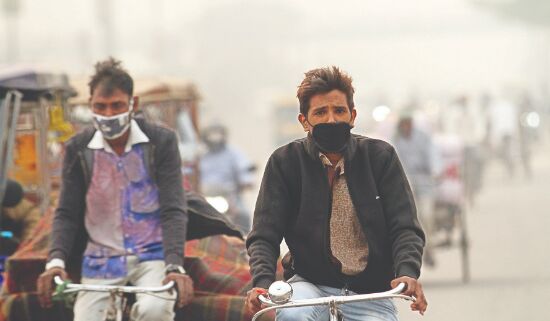Farm fires' share soars to 42%; Delhi's air worst since last Dec

New Delhi: Delhi's air quality on Thursday dropped to its worst level since December last year, with farm fires in neighbouring states accounting for 42 per cent of its pollution, the maximum this season so far, according to data from central government agencies.
Experts said unfavourable meteorological conditions such as calm winds, low temperatures and smoke from farm fires in neighbouring states led to a dense layer of haze on Wednesday night as the air quality index entered the 'severe' zone. The haze, however, thinned on Thursday with higher wind speeds, nonetheless, leaving the day's average air quality index at 450, the highest since December 30 last year.
All the 36 monitoring stations in Delhi recorded air quality in the "severe" category. The neighbouring cities of Faridabad, Ghaziabad, Greater Noida, Gurgaon and Noida also recorded "severe" air pollution.
PM10 levels in Delhi-NCR stood at 563 micrograms per cubic metre ( g/m3) at 10 am, the highest since November 15 last year, when it was 637 g/m3. It came down to 497 g/m3 by 5 pm, according to CPCB data. PM10 levels below 100 g/m3 are considered safe in India. The level of PM2.5 - finer particles that can even enter the bloodstream - were 360 g/m3 at 12 noon. PM2.5 levels up to 60 g/m3 are considered safe.
The Ministry of Earth Sciences' air quality monitor, SAFAR, said the farm fire count in Punjab, Haryana, Uttar Pradesh, Uttarakhand and neighbouring areas increased significantly and stood at 4,135 on Wednesday, the highest in this season so far.
SAFAR predicted conducive conditions for the dispersion of pollutants over the next two days. "The share of stubble burning in Delhi's PM2.5 pollution was estimated at 42 per cent on Thursday, it said.
"Better dispersion condition and not so low daytime boundary layer height is predicted for the next two days which is likely to improve AQI unless more than estimated fire-related emission takes place."
On Wednesday evening, the noxious haze reduced visibility to merely 600 metres at the Safdarjung Observatory, smudging landmarks from view. It was 1,200 metres on Thursday morning. In addition, a large number of people across the Delhi-NCR burst firecrackers to mark the Karwa Chauth festival.
"I can feel the pollutants in my throat despite wearing a mask. My eyes are burning. It is going to make the pandemic worse. I am scared," said Piyush Vohra, a resident of Jangpura.
V K Soni, the head of IMD's environment monitoring research centre, said the haze was primarily smoke from stubble burning in Punjab and Haryana. Unfavourable meteorological conditions trapped it in Delhi-NCR, he said.



